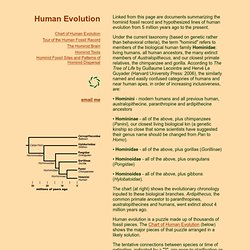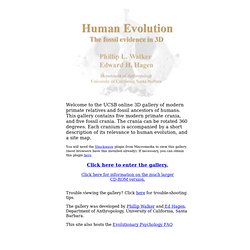

Browse the Talk.Origins Archive. Dinosaurnews Webzine. A Guide to the Orders of Trilobites. Strange Science: The Rocky Road to Modern Paleontology and Biology. INDEX. Ancestral Lines. Evolutionary biologists use a cladogram, the treelike diagram of evolutionary branches or clades, to organize species into lines of evolutionary descent across time.

Biologists use three types of evidence to deduce evolutionary connections: genetics, morphology, and geologic dating. (Behavior, normally a key part of evolutionary studies, can only be inferred in extinct species — for example, by examining the ecology in which the species flourished and the species adaptations for eating and locomotion.) Analyses of primate fossils and the genetic relatedness of living primates converge to the conclusion that humans and chimpanzees branched from a common ancestor about 7 million years ago. DNA recovered from several uncontaminated Neanderthalensis fossils indicated that modern humans and extinct neanderthals diverged about 400,000 years ago; but more recent studies show that they must have interbred within Europe or the Middle East since then.
Human Evolution: The fossil evidence in 3D. Welcome to the UCSB online 3D gallery of modern primate relatives and fossil ancestors of humans.

This gallery contains five modern primate crania, and five fossil crania. The crania can be rotated 360 degrees. Each cranium is accompanied by a short description of its relevance to human evolution, and a site map. You will need the Shockwave plugin from Macromedia to view this gallery (most browsers have this installed already). If necessary, you can obtain this plugin here. Dougal Dixon "Man after man. An anthropology of the future" Foreword by Brian Aldiss.
It has become necessary to look into the future.

There must have been a time, long past, when animals much like apes looked up into the night sky and wondered about the stars: what those pinpoints of light were, and what they were for. Only a brief while after that, the apelike things acquired language; then stories began to be told, and fantasies woven about the stars overhead. That cluster resembled a hunter and, high above, the outlines of a great bear could be discerned. The Smithsonian Institution's Human Origins Program. Darwin Pond. Flyfish. Flyfisher.